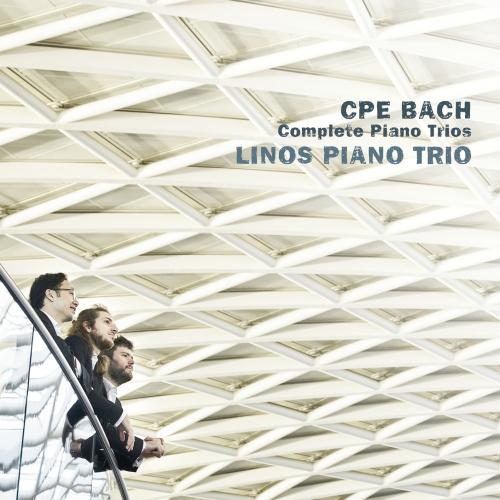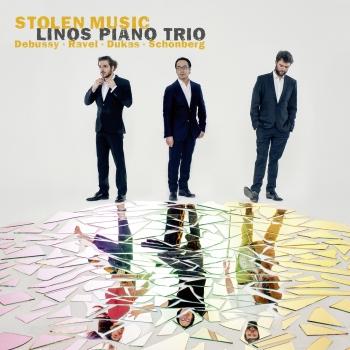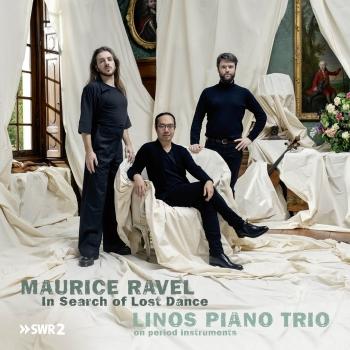
C.P.E. Bach: Complete Piano Trios Linos Piano Trio
Album info
Album-Release:
2014
HRA-Release:
22.05.2020
Label: CAvi-music
Genre: Classical
Subgenre: Chamber Music
Artist: Linos Piano Trio
Composer: Carl Philipp Emanuel Bach (1714-1788)
Album including Album cover Booklet (PDF)
- Carl Philipp Emanuel Bach (1714 - 1788): Piano Trio No. 5 in E Minor, Wq 89:
- 1 Piano Trio No. 5 in E Minor, Wq 89: I. Allegretto 04:54
- 2 Piano Trio No. 5 in E Minor, Wq 89: II. Larghetto 01:20
- 3 Piano Trio No. 5 in E Minor, Wq 89: III. Allegro 01:48
- Piano Trio No. 2 in C Major, Wq 89:
- 4 Piano Trio No. 2 in C Major, Wq 89: I. Andantino grazioso 05:03
- 5 Piano Trio No. 2 in C Major, Wq 89: II. Larghetto 01:23
- 6 Piano Trio No. 2 in C Major, Wq 89: III. Allegro 04:35
- Piano Trio No. 3 in A Major, Wq 89:
- 7 Piano Trio No. 3 in A Major, Wq 89: I. Allegretto 05:29
- 8 Piano Trio No. 3 in A Major, Wq 89: II. Arioso 01:11
- 9 Piano Trio No. 3 in A Major, Wq 89: III. Allegro di molto 02:34
- Piano Trio No. 6 in D Major, Wq 89:
- 10 Piano Trio No. 6 in D Major, Wq 89: I. Allegro 02:45
- 11 Piano Trio No. 6 in D Major, Wq 89: II. Andantino 02:56
- 12 Piano Trio No. 6 in D Major, Wq 89: III. Allegro 03:22
- Piano Trio No. 1 in B-Flat Major, Wq 89:
- 13 Piano Trio No. 1 in B-Flat Major, Wq 89: I. Allegretto 05:51
- 14 Piano Trio No. 1 in B-Flat Major, Wq 89: II. Larghetto 03:11
- 15 Piano Trio No. 1 in B-Flat Major, Wq 89: III. Allegro 03:46
- Piano Trio No. 4 in E-Flat Major, Wq 89:
- 16 Piano Trio No. 4 in E-Flat Major, Wq 89: I. Andantino 04:39
- 17 Piano Trio No. 4 in E-Flat Major, Wq 89: II. Andante 01:46
- 18 Piano Trio No. 4 in E-Flat Major, Wq 89: III. Tempo di Minuetto 02:45
- Piano Trio No. 4 in E-Flat Major, Wq 91:
- 19 Piano Trio No. 4 in E-Flat Major, Wq 91: I. Andante 05:19
- 20 Piano Trio No. 4 in E-Flat Major, Wq 91: II. Adagio 01:22
- 21 Piano Trio No. 4 in E-Flat Major, Wq 91: III. Allegretto 03:36
- Piano Trio No. 3 in C Major, Wq 90:
- 22 Piano Trio No. 3 in C Major, Wq 90: I. Allegro di molto 04:02
- 23 Piano Trio No. 3 in C Major, Wq 90: II. Larghetto 02:33
- 24 Piano Trio No. 3 in C Major, Wq 90: III. Allegretto 04:16
- Piano Trio No. 1 in A Minor, Wq 90:
- 25 Piano Trio No. 1 in A Minor, Wq 90: I. Presto 04:05
- 26 Piano Trio No. 1 in A Minor, Wq 90: II. Andante 01:58
- 27 Piano Trio No. 1 in A Minor, Wq 90: III. Presto ma non troppo 02:33
- Piano Trio No. 2 in G Major, Wq 90:
- 28 Piano Trio No. 2 in G Major, Wq 90: I. Allegretto 04:41
- 29 Piano Trio No. 2 in G Major, Wq 90: II. Larghetto 00:39
- 30 Piano Trio No. 2 in G Major, Wq 90: III. Grazoioso e poco allegro 04:50
- Piano Trio No. 1 in E Minor, Wq 91:
- 31 Piano Trio No. 1 in E Minor, Wq 91: I. Allegretto 04:09
- 32 Piano Trio No. 1 in E Minor, Wq 91: II. Poco andante 01:03
- 33 Piano Trio No. 1 in E Minor, Wq 91: III. Allegretto 03:09
- Piano Trio No. 2 in D Major, Wq 91:
- 34 Piano Trio No. 2 in D Major, Wq 91: I. Allegretto 05:32
- 35 Piano Trio No. 2 in D Major, Wq 91: II. Andante 00:45
- 36 Piano Trio No. 2 in D Major, Wq 91: III. Allegretto grazioso 03:59
- Piano Trio No. 4 in C Major, Wq 91:
- 37 Piano Trio No. 4 in C Major, Wq 91: Arioso 14:32
Info for C.P.E. Bach: Complete Piano Trios
„In Hamburg, 1775, Carl Philipp Emanuel Bach, by then an internationally celebrated and well-connected figure, was surely aware of the genre’s popularity. After all, his half-brother, the London-based Johann Christian, was central in promoting this new culture of domestic piano playing. Responsive to the market demand, C.P.E. came to an agreement with the London publisher Bremner to publish the following year Six Sonatas for the Harpsichord or Pianoforte accompanied by Violin and Violoncello (Wq. 89). Despite the title, Bach referred to these works at times as Trios, at times as Sonatas, and sometimes even as “Trios (which are also Solos)”.
It seems he didn’t really know what to call them, as they sat in between his previously clear categories of Trios (in the Baroque trio-sonata format of two equal instrumental parts accompanied by basso continuo), keyboard solo works, and the “Soli” (works for various solo instruments to be accompanied by the continuo). His ambivalence towards this fashionable new genre was evident in a letter where he contemptuously referred to the
accompanied sonatas as a “non- or half-entity”.
But regardless, the publication was exceedingly successful, and Bach enjoyed what he probably considered a nice bonus to his usual duties of writing religious choral works: “I am having more luck than I have the right to expect. People are crazy about my modest concoction, from which one may profit.” He published two further sets (Wq. 90 and 91) with Breitkopf in Germany in 1776 and 1777, to great success.
Business acumen aside, these works reveal C.P.E. Bach at the height of his career and are full of invention, expression, and shocking surprises that at times surpass what even Beethoven might dare to do..…..“ (Excerpt from the liner notes by Linos Piano Trio)
Linos Piano Trio
Linos Piano Trio
“Reinventing the repertoire”: it may seem like a tall order, but this is how the Linos Piano Trio describes the philosophy at the heart of its music making. This reinvention comes about in two ways. The first is through the musicians’ interpretations of the core repertoire; they look at each piece as if it were newly composed, setting conventions aside and bringing it to light in a fresh and personal way. The second is by extending the breadth of the repertoire in order to expand the range of works listeners are traditionally presented in piano trio recitals, be that through commissioning new music, their own arrangements of pieces written for different types of ensembles, or through championing unjustly neglected works.
First Prize and Audience Prize winner of the Melbourne International Chamber Music Competition 2015, the Linos Piano Trio is increasingly recognised as one of Europe’s most creative and dynamic trios.
Drawing on the rich and varied cultural and musical backgrounds of its members, which encompass five nationalities, as well as specialisms in historically informed performance and new music, the Linos Piano Trio possesses a colourful and distinctive musical voice. Praised for its “slow-burning, gripping performance” by The Strad, and an “astounding performance” by the Hannoversche Allgemeine Zeitung, the trio’s reputation has taken it to prestigious venues worldwide including the Barbican and Wigmore Halls, Melbourne Recital Centre, Muziekgebouw Eindhoven, Holzhausenschlösschen in Frankfurt, Théâtre Saint-Louis in France, and the György Ligeti Saal in Graz.
Founded in October 2007, the Linos Piano Trio studied at the Guildhall and then at the Musikhochschule Hannover with Oliver Wille and Markus Becker. The ensemble has also received the guidance of Sir András Schiff, Peter Cropper, Ferenc Rados, Rainer Schmidt and Eberhard Feltz. The trio first came to prominence in the Tunnell Trust Showcase for Young Musicians, and in 2014 was awarded the Royal Philharmonic Society’s Albert and Eugenie Frost Prize for an outstanding ensemble.
The Linos Piano Trio recorded the complete Piano Trios by C.P.E. Bach to celebrate the 300th anniversary of his birth, and the CDs will be released by CAvi-music this summer. In 2016 the trio embarked on its current, on-going project, ‘Stolen Music’, a rapturously received series of creative arrangements of orchestral masterpieces such as Wagner’s Prelude to Tristan and Isolde, and Dukas’ Sorcerer’s Apprentice.
The Linos Piano Trio recently made their debut appearance in Italy, and their busy 2019-20 season includes numerous performances across the UK as well as concerts in France and Germany.
Since 2017 they have held the position of ‘Artists-in-Residence’ at Trinity Laban Conservatoire in London.
Linos (Λῖνος) was a celebrated musician in Greek mythology. The son of Apollo, Linos received from his father the three-stringed lute, and became known as the inventor of new melodies, lyric songs, and eloquent speech. As one of the original demi-gods of music, Linos had many pupils, most famously Heracles and his brother Orpheus.
Booklet for C.P.E. Bach: Complete Piano Trios












